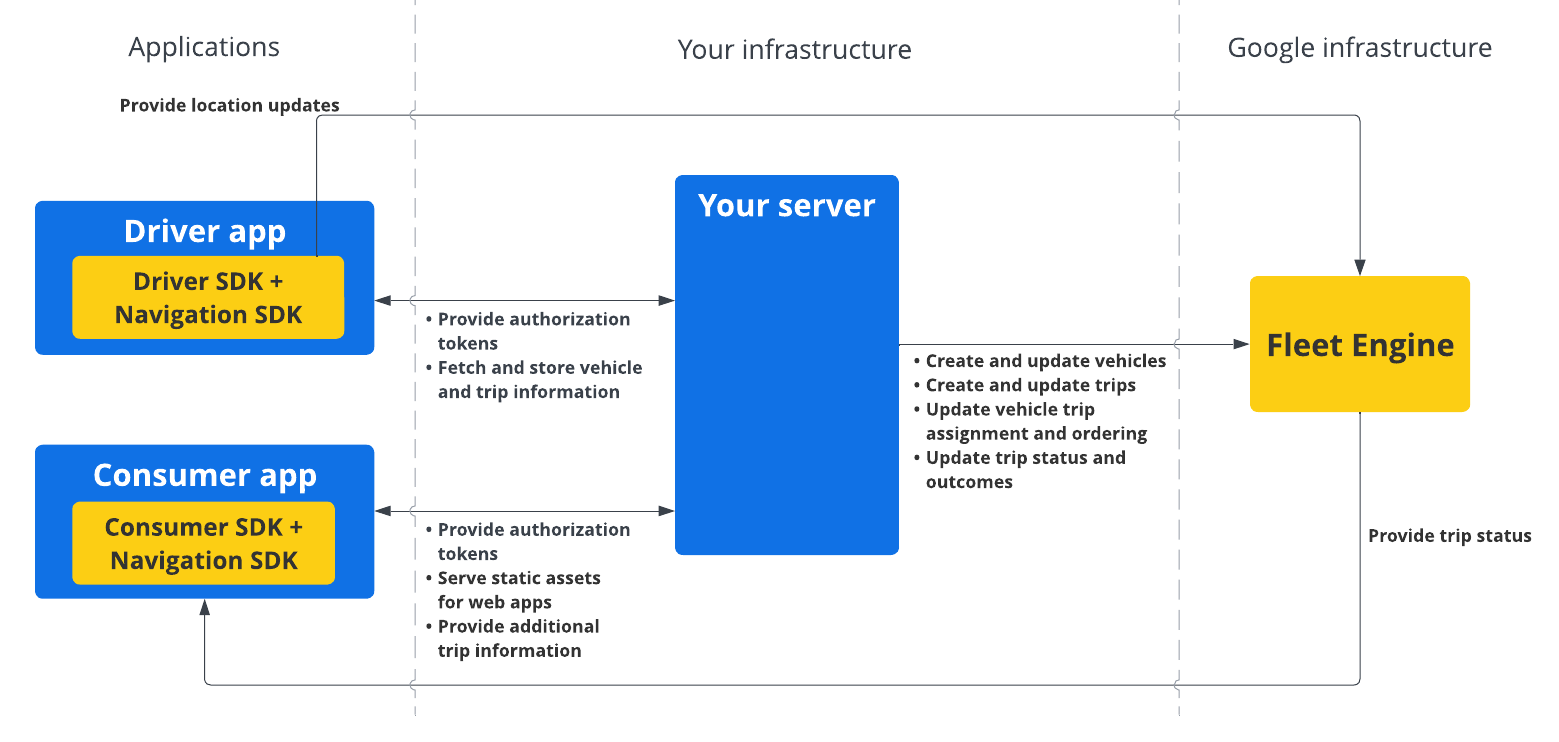Driver SDK هي مجموعة أدوات لتطبيقات الأجهزة الجوّالة ومكوّن أساسي من Fleet Engine. باستخدام حزمة تطوير البرامج هذه، يمكن لتطبيق السائق إدارة الرحلات المخصّصة وتفعيل إمكانات التنقّل وتحديد المسار للسائق.
قبل البدء
يفترض هذا الدليل أنّك قرأت ما يلي:
- أساسيات Fleet Engine
- نموذج البيانات الخاص بالمركبات
- نموذج البيانات للرحلات عند الطلب
- كيفية إعداد Fleet Engine
- كيفية إنشاء المركبات واستخدامها في Fleet Engine
ما هي حزمة تطوير البرامج (SDK) للسائقين للرحلات عند الطلب؟
تتواصل حزمة تطوير البرامج Driver SDK مع Fleet Engine لإرسال بيانات الموقع الجغرافي للمركبة وتعديلات الرحلة، ما يتيح لـ Fleet Engine تتبُّع المركبات والرحلات المخصّصة لها. تستخدم حزمة تطوير البرامج (SDK) في جوهرها أداة معالجة الأحداث لإرسال آخر المعلومات عن الموقع الجغرافي وإحداثيات خطوط الطول والعرض، بالإضافة إلى جزء المسار الحالي والوجهة من حزمة Navigation SDK إلى Fleet Engine عندما يبدأ السائق القيادة.
لماذا يجب استخدام Driver SDK للرحلات عند الطلب؟
تتيح حزمة Driver SDK إمكانية الدمج بسهولة أكبر مع Fleet Engine لتعديل مسارات السائق. باستخدام حزمة تطوير البرامج هذه، يمكن للسائق استخدام تطبيق واحد لإدارة المهام والتنقّل كما يفعل باستخدام الإصدار المخصّص للمستهلكين من "خرائط Google"، ولكن بدون الحاجة إلى التبديل إلى تطبيق آخر.
الإجراءات التي يمكنك تنفيذها باستخدام Driver SDK للرحلات عند الطلب
استخدِم حزمة تطوير البرامج (SDK) للسائق في الرحلات عند الطلب لإرسال المعلومات التالية إلى Fleet Engine:
- موقع المركبة في الوقت الفعلي على الخريطة
- إحداثيات خط العرض/الطول لنقاط طريق الرحلة التي توفّرها حزمة تطوير البرامج للتنقّل
- المسافة المتبقية إلى نقطة الطريق التالية
- الوقت المقدَّر للوصول إلى نقطة الطريق التالية
- المسار الذي يجب أن تسلكه المركبة كما هو مقدَّم من خلال حزمة تطوير البرامج Navigation SDK
طريقة عمل Driver SDK للرحلات عند الطلب
تعتمد حزمة Driver SDK على حزمة Navigation SDK للحصول على معلومات التوجيه والوجهة. بالإضافة إلى المعلومات الواردة من حزمة تطوير البرامج (SDK) الخاصة بخدمة Navigation، تتكامل حزمة تطوير البرامج (SDK) الخاصة بالسائق مع تطبيق السائق وتوفّر لخدمة Fleet Engine مجموعة من آخر المعلومات حول الموقع الجغرافي وإحداثيات خطوط الطول والعرض والمسافة المتبقية وتقديرات الوقت المتوقع للوصول. يجب إرسال جميع تعديلات بيانات المركبات الأخرى إلى الخلفية الخاصة بالعميل، والتي تنقل البيانات إلى Fleet Engine.

كيفية استخدام Driver SDK للرحلات عند الطلب
اختَر نظام التشغيل للاطّلاع على كيفية بدء استخدام Driver SDK.
Android
| 1 | الحصول على Driver SDK لنظام التشغيل Android | لمزيد من المعلومات، راجِع الحصول على Driver SDK. |
| 2 | إعداد مشروع في "وحدة تحكّم Google Cloud" | لمزيد من المعلومات، يُرجى الاطّلاع على إعداد مشروع في وحدة تحكّم Google Cloud. |
| 3 | تحديد الاعتماديات | لمزيد من المعلومات، راجِع مقالة تعريف التبعيات. |
| 4 | إنشاء رموز مميزة للمصادقة | لمزيد من المعلومات، يُرجى الاطّلاع على إنشاء رموز مميّزة للمصادقة. |
| 5 | إعداد حزمة تطوير البرامج (SDK) الخاصة بالسائق | لمزيد من المعلومات، يُرجى الاطّلاع على تهيئة حزمة تطوير البرامج (SDK) الخاصة بالسائقين. |
| 6 | تجهيز المركبة | لمزيد من المعلومات، يُرجى الاطّلاع على تجهيز المركبة. |
| 7 | ضبط تفاصيل الرحلة | لمزيد من المعلومات، يُرجى الاطّلاع على ضبط تفاصيل الرحلة. |
iOS
| 1 | الحصول على Driver SDK لنظام التشغيل iOS | لمزيد من المعلومات، راجِع الحصول على Driver SDK. |
| 2 | إعداد مشروع في "وحدة تحكّم Google Cloud" | لمزيد من المعلومات، يُرجى الاطّلاع على إعداد مشروع في وحدة تحكّم Google Cloud. |
| 3 | إنشاء رموز مميزة للمصادقة | لمزيد من المعلومات، يُرجى الاطّلاع على إنشاء رموز مميّزة للمصادقة. |
| 4 | إعداد حزمة تطوير البرامج (SDK) الخاصة بالسائق | لمزيد من المعلومات، يُرجى الاطّلاع على تهيئة حزمة تطوير البرامج (SDK) الخاصة بالسائقين. |
| 5 | تجهيز المركبة | لمزيد من المعلومات، يُرجى الاطّلاع على تجهيز المركبة. |
| 6 | ضبط تفاصيل الرحلة | لمزيد من المعلومات، راجع تعيين تفاصيل الرحلة. |
الخطوات التالية
راجِع مستندات النظام الأساسي الذي تريد إعداد حزمة Driver SDK عليه:

